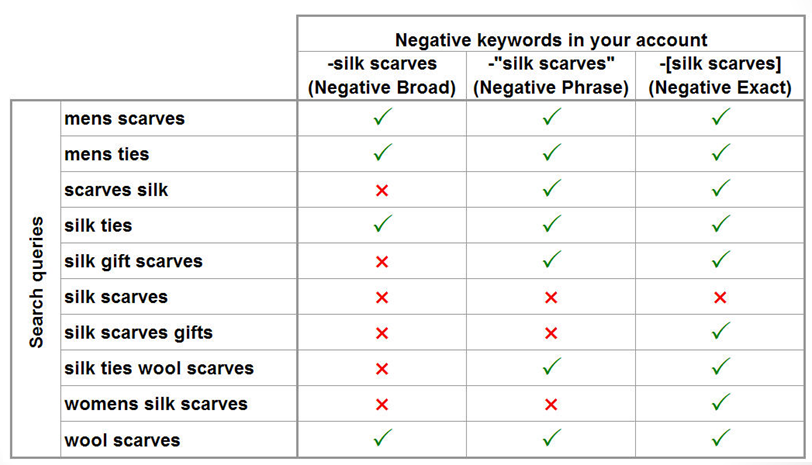Negatives are keywords that enable advertisers to prevent ads from appearing when specific terms are a part of a user’s search query. They help keep ads from being shown on non-relevant queries. This results in an improving performance and subsequently in increasing returns on investment. The specific effects are:
- Decrease of unwanted impressions increases CTR without raising clicks
- Direction of traffic to better ads increases CTR, clicks, and conversions
Negative match types
Example Negative: [red shoes]
Will match to: red shoes
Will not match to: anything else
Example Negative: “red shoes”
Will match to: buy red shoes, red shoes store, red shoes on sale, …
Will not match to: red leather shoes, shoes red, red sandals, …

The figure shows how the same keyword operates under different match types in practice.
Negatives in the Account Structure
An account mainly consists of three main levels:
- Account level
- Campaign level
- Ad group level
Negatives can be implemented on each of these levels. Account Negatives are set in the so-called Shared Library and are applied to all campaigns. Campaign Negatives are set to a specific campaign and apply to every ad group belonging to that campaign. They are used for keywords we want to prevent from getting triggered anywhere in this campaign. Ad Group Negatives are assigned to a single ad group and thus prevent all ads within the chosen ad group to show for the negative keyword.
Types of Negatives
There are two main types of negatives. Firstly, blocking negatives isolate certain or all campaigns from keywords associated with undesired topics. These are global negatives and standard negatives. Secondly, there are structural negatives that redirect traffic to the most relevant keyword. Different types include “Inline negatives”, “Match Type negatives”, and “Punk negatives”.
Blocking Negatives
Example:
Advertisers of the clothing brand “Puma” would implement “wild cats” and “zoo” as standard negatives for their campaigns to be “protected” from irrelevant traffic.
Structural Negatives:
Example:
An advertiser books the following ad groups:
- [Cat|Color]{exact}: green shoes (keyword: [green shoes])
- [Cat|Color]{broad}: green shoes (keyword: green shoes)
Now, if a customer searches for green shoes, the more expensive broad ad might be triggered although a more relevant exact ad is registered. Therefore, the advertiser should insert the match type negative –[green shoes] to the broad ad group, to reallocate the traffic to the exact keyword.
If the negative was a broad negative, some impressions would be lost. Whenever a user searches for “shoes green”, the exact keyword will not be triggered, but the negative would prevent the broad one from being triggered. The negative implemented in the broad ad group must have the same match type as the keyword, which is to be triggered.
Example:
An advertiser books the following ad groups:
- [Cat|Ecom]{phrase}: Shoes Shop (keyword: “shop shoes”)
- [Cat|Ecom]{phrase}: Shoes Online Shop (“online shop shoes”)
According to these ad groups, the advertiser should add the negative –“online shop shoes” as an inline negative on ad group level to the shorter keyword.
Example:
An advertiser books the following ad groups:
- [Cat]{phrase}: shoes (keyword: “shoes”)
- [Cat|Color]{phrase}: green shoes (keyword: “green shoes”)
According to these ad groups the advertiser should book the extension (in this case “green”) as a punk negative on an ad group level to the shorter ad group.
Finding negatives
There are several practices that one can make use of when trying to generate valuable negatives. The first practice that you can make use of is brainstorming. Moreover, creating a mind map can make it easier to categorize your thoughts. Second, the Google Keyword Planner can support you in the search for negatives. This tool helps you find suggestions for a keyword of your choice. This might give you input when looking for keywords as well as negatives. Third, you can make use of the reports that can be accessed through your Google Ads account. These reports can help you check the performance of all keywords, search terms (user’s queries), ads, ad groups, campaigns, or partly selected elements.
Negatives are not only useful to block ads for search queries that are not relevant for your business. Furthermore, they empower you to direct traffic more specifically than Google allows you to by default. A good negative structure is crucial to maintain high CTR’s and high quality account data.
– Yuliya Chosik, Associate Account Consultant

